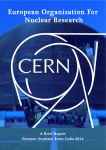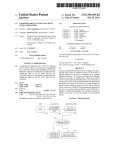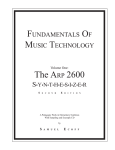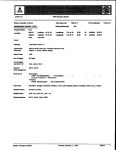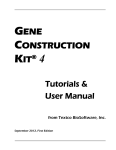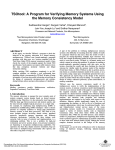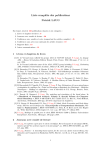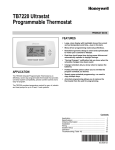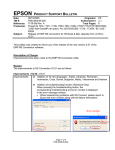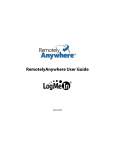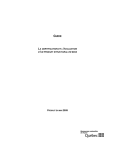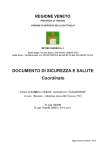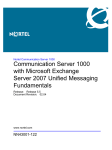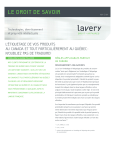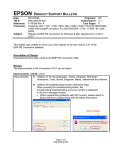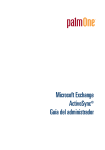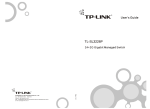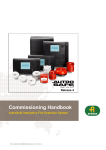Download Systems and methods for delegation and notification of
Transcript
US008484703B2 (12) United States Patent (10) Patent No.: Kenny et al. (54) (75) (45) Date of Patent: SYSTEMS AND METHODS FOR 5,583,940 A 12/1996 Vidrascu et a1. .............. .. 380/49 5,696,486 A 12/1997 ADMINISTRATION OF INTERNET ACCESS 5,732,212 A 5,832,212 A 3/1998 PerholtZ et al. .. 395/200.11 11/1998 Cragun et a1. ......... .. 395/188.01 5,835,722 A ll/l998 Inventors: Shane Kenny, AcWorth, GA (U S); . . . . . .. 340/506 Bradshaw et al. ..... .. 395/200.55 (Commued) FOREIGN PATENT DOCUMENTS (73) Assignee. McAfee, Inc., Santa Clara, CA (US) Notice: DE 19359052 EP 0554182 Subject to any disclaimer, the term of this OTHER PUBLICATIONS APPI' NO. 12/464 504 “enKoo Remote Access Appliance,” Dreaming Tree Technology, Inc. ’ http://WWW.ssltunnel.com/default.asp, 2 pages, printed from the May 12, 2009 (65) Internet Jun. 14, 2005. (Continued) Prior Publication Data Us 2009/0222894 A1 8/1993 (Commued) U30 154(1)) by 162 days- Filed. 9/l996 _ patent is extended or adjusted under 35 (22) Poliquin et al. . . . . _ Aaron Kenny, Dallas, GA (U S) (21) Jul. 9, 2013 DELEGATION AND NOTIFICATION 01: _ (*) US 8,484,703 B2 Sep. 3, 2009 Primary Examiner * Nathan Flynn Assistant Examiner * Michael R Vaughan Related U 5 Application Data (63) (60) 51 (74) Attorney, Agent, or Firm * Patent Capital Group Continuation of application No. 11/244,542, ?led on Oct‘ 6’ 2005' Provisional application No_ 60/616,490’ ?1ed on QCL 6, 2004, provisional application No_ 60/646,234’ ?1ed (57) ABSTRACT Disclosed are systems, methods, and computer readable media for delegating administrative rights to a third party in an Internet access control application comprising receiving a on Jan 24, 2005' designation of a third party Wherein the designation identi?es the third party as a recipient of administrative rights in an Int. Cl. access control aPP lication, and receiving a selection of H04L 29/06 (2006.01) administrative rights to be associated With the third party. (52) US, Cl, USPC ................ .. 726/4; 726/29; 709/224; 709/225 Further, an invitation can be sent, or caused to be sent, to the third party- Acceptance Of Said invitation can be received (58) Field of Classi?cation Search None See application ?le for Complete Search history Also, administrative rights can be granted to the third party. The systems, methods, and computer readable media can be operable Within a client/server architecture. Also disclosed are systems, methods, and computer readable media for noti (56) References Cited ?cation of an access policy violation. Also disclosed are sys tems, methods, and computer readable media for administra tion of an access control application by a third party and access policy violation noti?cation. U.S. PATENT DOCUMENTS 5,237,677 A 8/1993 Hirosawa et al. ........... .. 395/575 5,490,216 A 5,557,742 A 2/1996 Richardson, III 9/1996 Smaha et al. 20 Claims, 9 Drawing Sheets Add 501 elegation Sta input Email , 002 Of Person To Delegate To 1 Set f sos Delegation Parameters 1 Save New r 604 Delegation 1 Send Delegation Invitation Ad d Delegation En 606 US 8,484,703 B2 Page 2 US. PATENT DOCUMENTS OTHER PUBLICATIONS 5,889,958 A 3/1999 Willens .................. .. 395/200.59 5,941,996 A 8/l999 Smith et a1‘ ‘ 5,944,782 A 5,958,010 A 8/1999 Noble et a1‘ ' 709/202 9/1999 Agarwal et al. ............. .. 709/224 2 , ““ “ 714/47 granc?ek et a1~ , reun 713001 “ >> , GoToMyPC, https.//www.gotomypc.com/tr/ggp/mb/aw/remote. access.computer-broad/g25ggllp?Target:mm/g25ggllp.tmpl, page, printed from the Internet Jun. 14, 2005. 1 “iPrismiInternet Access Management,” 1s’4Computer-Networks. ........................ .. , _ _ - - 6,012,100 A 1/2000 Frailong et al. . 709/250 co'uk 6,026,438 A 2/2000 . 709/221 Pages’ Pm‘ e . 709/224 “My WebEX PC,” httpI//WWW~WebeX~con?p/aaphpi’typFkeyword, Piazza et al. ..... .. 6,035,322 A 3/2000 Ingrassia, Jr. et al. 6,052,730 A 4/2000 Felciano et al. ............ .. 709/225 27%;? , $1 gelger et 6,289,378 B1 * “1" ’ 1 page, printed from the Internet Jun. 14, 2005. 40001 Mastmngelo et a1‘ ““““ " 714/38 ggggnvimanualsh?nla 10 Pages, Pflnted from the Internet JuI1~ 9, 9/2001 . .............. .. - Meyer et al. ................ .. 709/223 12/2001 Collin et a1, ' _ , 709/220 “Remote Computer Access Software,” NetworkStream1ng, http:// . 709/229 www.networkstreaming.com/indeX.htm, 1 page, printed from the 6,397,256 B1 5/2002 Chan et al. .. 6,446,119 B1 9/2002 Olah et al. .................. .. 709/224 gift‘; 2: :11‘ 709/224 Internet Jun, 14, 2005, “Remotely Access your PCs + servers from anywhere,” Remotely 6:578:146 B2 6/2003 Johnson ........................ 713/189 Anywhere’ 6,606,659 B1 8/2003 Hegli et a1‘ cess.asp, 1 page, pr1nted from the Internet Jun. 14, 2005. 6,615,255 B1 6,631,363 B1 9/2003 BlasZcZak ................... .. 709/220 10/2003 Brown et al. ................... .. 707/1 1 6’675’l93 B 1 4 ' “NetViZor User Manual,” WareSight.com http://www.waresight. awson e 6,330,597 B2 e n ‘me 709/224 , 6,219,804 B1 I I distlcfmplit? negtwgglgss'co'uldlpnsmmm mm $2,052’ et a1‘ 3797/53” H2004 Sign 709/2'00 “Server Monitoring,” ServerMojo.com http://www.servermojo. com/, 2 pages, printed from the Internet Jun. 9, 2005. “SurfControl WebFilter 5.0,” ISAServerorg http://www.isaserver. org/articles/Review-SurfControl-Web-Filter-ISA-Server-2004. 638953285 B2 5/2005 Maity ““ “““““““““ 7,194,464 B2 3/2007 Kester et al. US. Appl. No. 11/244,542, ?led Oct. 6, 2005, Shane Kenny, 1. 7,363,656 B2 4/2008 “gebef et 31 Response to Non-Final Of?ce Action, Dec. 8, 2009, 2. Non-Final 7,406,715 B2 7 2008 C aPPer Of?ce Action Jun. 8 2009. 7,506,155 B1 3/2009 20011 Jones et 31‘ US. Appl. No. 60/616,490, ?led Oct. 6, 2004, Shane Kenny. 7,900,239 B2 * 3/2011 van SOInereIl .................. .. 726/1 U~S~App1~N9~ 60,646,234,?1ed1an~ 24. 2005. Shane Kenny. 8,010,552 B2 8/2011 Kestef et 31 83315131 Spytech Software and Design, Inc., “Spytech NetviZor,” SpyTech Online, Oct. 3, 2003, Internet Archive, http://web.archive.org/web/ 7,890,642 B2 * Stewart et al. resc 2002/0087650 2002/0166069 2002/0174367 2003/0033450 700/27 mp1” W W W'remotelyanywhere‘onvdmcq/remoteac' ’ ~~~~~~~~~~~~~~ ~~ ere html, 4 pages, printed from the Internet Jun. 9, 2005. a. .. ’ . A1 * 7/2002 Fagerburg et al. . A1 * 11/2002 Zendzian “““ “ A1 * 11/2002 Kimmel et al. A1 2/2003 Appleby-Alis . , _ . 709/208 ‘ 713001 . 713/201 710/8 20031003021346/http'// .‘Spytech web'conv' USPTO Non?nal Of?ce Act1on from US. Appl. No. 11/244,542, malled Jun~ 8, 2009 (14 Pages) USPTO Final Of?ce Action from US. Appl. No. 11/244,542, mailed 2003/0110168 A1 6/2003 Kester et al. Feb. 23, 2010 (10 pages). 2003/0123465 A1 720% Donflhlge Mai ~~~~~~~~~~~~~~~~ ~~ 370/401 USPTO Non?nal Of?ce Action from US. Appl. No. 11/244,542, 2003 0135382 A1 7 2003 Marje 2003/0207237 A1 11/2003 2004/0003279 A1 * 2004/0158630 A1 2004/ 0186989 A1 et . GieZerman 9/ 2004 Clapper 2004/0230530 A1 2004/0267595 A1 ?led Dec‘ 8, 2009 (17 pages)‘ ................. .. 434/118 V2004 Beilinson et a1‘ ““““““ “ 713/200 8/2004 Chang et a1. ................ .. 709/224 _ _ USPTO Response to Jun. 8, 2009 Non?nal Re]ect1on from U.S.Appl. N9 11/244,542,?1ed13e0~ 8, 2009 (17 Pages) USPTO Response to Feb. 23, 2010 Final Rejection from US. Appl. 11/2004 Searl et al. .................... .. 705/51 12/2004 Woodlngs et a1~ ~~~~~~~~~~~~~~ ~~ 705/9 gggg/ggég?g 2} $882 Singer et 31a. Zoos/0060581 A1 2005/0080897 A1 * 300% Chebolu et a1‘ “““““““ “ 713001 4/2005 Braun et al. ................ .. 709/225 USPTO F1nal Of?ce Act1on from US. Appl. No. 11/244,542, ma1led Man 17, 2011 (11 Pages) 2005/0102407 A1 5/2005 Clapper USPTO Jun. 7, 2011 RCE Response to Mar. 7, 2011 Final Of?ce 2005/0102510 A1* 5/2005 Patrick et al. ............... .. 713/166 * gangalIllathgln .............. ~~ 713/201 0 amma 068° 2005/0183143 A1* 8/2005 er 1oune t 31 . .. 709/206 No. 11/244,542, ?led Jul. 23, 2010 (13 pages). USPTO Response to Aug. 2, 2010 Non?nal Rejection from US. ~ A1 9/2006 . . . Action from US. Appl. N0. ll/244,542. Non-Final Of?ce Action in US. Appl. No. 11/244,542 mailed 0n Mar. 15, 2012. Anderholm et al. .. 726/22 2005/0289226 A1 * 12/2005 Mohammed et al. ....... .. 709/208 2006/0218575 Appl. No. 11/244,542, ?led Feb. 2, 2011 (10 pages). Blair 6 _ on 2007/0179950 A1 2007/0222589 A1 8/2007 Kester et a1‘ 9/2007 Gorman et al. - - glesfonsi/lto T222111‘? Of?ce Act1on 1“ U'S' Appl' No‘ 11044542 ay ’ _ ' _ Not1ce ofAllowance 1n U.S. Appl. No. 11/244,542 ma1led on Jul. 24, 2012 2008/0155685 A1 * 6/2008 Beilinson et al. ............. .. 726/21 Request for Continued Examination in US. Appl. No. 11/244,542 2008/0201159 A1 8/2008 Gabrick et al. ................. .. 705/1 ?led on (M24101; 2012/0089500 A1* 4/2012 E2235 25:11‘ EP Dheer et al. Notice of Allowance in US. Appl. No. 11/244,542 mailed on Nov. .................. .. 705/35 FOREIGN PATENT DOCUMENTS 1318468 600% JP JP 5274177 7306800 10/1993 11/1995 JP 2003-233623 8/2003 20’ 2012' _ _ _ _ Request for Cont1nued EXam1nat1on 1n U.S. Appl. No. 11/ 244,542, ?led Feb. 19, 2013. Notice ofAllowance received for US. Appl. No. 11/244,542, mailed on Mar. 15. 2013. 6 Pages * cited by examiner US. Patent Jul. 9, 2013 Sheet 3 of9 US 8,484,703 B2 FIG. 3 Internet-Enabled Application 39 1 106--\ UDP 392 TCP/IPm /-—106 | Internet Access Control client | | Internet Access Control client | Network Adapter Internet or Private Network 108 m US. Patent Jul. 9, 2013 Sheet 4 of9 US 8,484,703 B2 401 ( Program ) Sta rt 402 as User Requested Website? FIG. 4 L0g_|n User ‘ #405 Get Website <— Category r408 410 \ B|°Ck N0 Log Usage Website 411 r407 Allow Website Are Notifications Handle Notifications No US. Patent Jul. 9, 2013 US 8,484,703 B2 Sheet 5 0f 9 Handle Notification No Increment Alert Counter ( 503 FIG. 5 504 ls Threshold No No Load First ( 506 Notification In List i ( 507 Send Notification f 509 Load Next Notification In List Yes Are There More Handle Notification End US. Patent Jul. 9, 2013 Sheet 6 0f 9 US 8,484,703 B2 FIG. 6 Add 601 Remove elegation Sta Delegaton Start Input Email / 602 Users Selects K 702 Of Person To Delegation To Delegate To Remove l Set / 603 Delegation Parameters l Save New f 604 Delegation l Send / 605 Delegation Remove Invitation Delegation End Add Delegation End 606 705 US. Patent Jul. 9, 2013 US 8,484,703 B2 Sheet 7 0f 9 FIG. 8 elegation Star Log Third Party Administrator In l Third Party Administrator Selects User K 803 1 Third Party Administrator Accesses And Administers User’s Account Use Delegation End f 805 804 US. Patent Jul. 9, 2013 Sheet 8 0f 9 FIG. 9 Set Threshold Start User Sets Threshold Parameters 901 r 902 l Validate Parameters / 903 l Save Threshold Parameters Set Threshold End f 904 905 US 8,484,703 B2 US. Patent Jul. 9, 2013 Sheet 9 0f 9 US 8,484,703 B2 FIG. 10 FIG. 11 Notification Start Remove Notification Start User Selects (1002 User Selects K1102 Notification Notification To Remove ?fe User Enters (1003 Notification Parameters Validate (1°04 Parameters Remove i Notification From List SaY? NW r1005 Not|f|cat|on To List Add Notification En Remove otification End <— US 8,484,703 B2 1 2 SYSTEMS AND METHODS FOR DELEGATION AND NOTIFICATION OF ADMINISTRATION OF INTERNET ACCESS ing general description and the following detailed description are exemplary and explanatory only and are not restrictive of the invention, as claimed. CROSS REFERENCE TO RELATED PATENT APPLICATIONS BRIEF DESCRIPTION OF THE DRAWINGS This application is a continuation of US. Utility applica tion Ser. No. 11/244,542, ?led Oct. 6, 2005 which claims priority to US. Provisional Application No. 60/616,490 ?led Oct. 6, 2004 and US. Provisional Application No. 60/646, 234 ?led Jan. 24, 2005, all of which are herein incorporated by reference in their entireties. and constitute a part of this speci?cation, illustrate embodi ments of the invention and together with the description, serve to explain the principles of the invention: FIG. 1 is a block diagram illustrating an exemplary oper The accompanying drawings, which are incorporated in ating environment for performing the disclosed method; FIG. 2 illustrates in an exemplary networked environment capable of performing the disclosed methods; FIG. 3 illustrates where an exemplary InternetAccess Con trol client can reside in a computing device; BACKGROUND OF THE INVENTION FIG. 4 illustrates operational steps in an exemplary Internet For many years, Internet Access Control applications have Access Control application; FIG. 5 provides exemplary steps involved in handling noti existed to allow users to control the type of content that can be accessed through their Internet connection. Additionally, the 20 ability to log all Internet usage of a user or access policy FIG. 6 illustrates exemplary steps involved in delegating violations has is known. However, in order to view these logs, administrative control to a third party; or be made aware of access policy violations, a user or a third FIG. 7 illustrates exemplary steps involved in removing party has to periodically check the logs. This does not permit instant noti?cation of an Internet Access Policy violation. Administration of Internet access control applications is also administrative control from a third party; 25 FIG. 8 illustrates exemplary steps involved in a third party administrator’s control of a user’s account; problematic. Typically, someone with administrative rights FIG. 9 illustrates exemplary steps involved in setting a threshold; controls the settings of an Internet access control application. FIG. 10 illustrates exemplary steps involved in adding a This can cause an issue if a user of an Internet access control application does not want access to the administration fea ?cations; 30 tures of the application. noti?cation to an Internet Access Control application; and FIG. 11 illustrates exemplary steps involved in removing a noti?cation from an Internet Access Control application. SUMMARY OF THE INVENTION DETAILED DESCRIPTION OF THE INVENTION Disclosed herein are systems, methods, and computer 35 readable media capable of delegating administrative rights to a third party in an Internet access control application com Before the present methods and systems are disclosed and described, it is to be understood that this invention is not prising receiving a designation of a third party wherein the designation identi?es the third party as a recipient of admin istrative rights in an access control application, and receiving to particular compositions, as such may, of course, vary. It is also to be understood that the terminology used herein is for limited to speci?c synthetic methods, speci?c components, or 40 the purpose of describing particular embodiments only and is a selection of administrative rights to be associated with the third party. Further, an invitation can be sent, or caused to be sent, to the third party. Acceptance of said invitation can be received. Also, administrative rights can be granted to the third party. The systems, methods, and computer readable not intended to be limiting. As used in the speci?cation and the appended claims, the singular forms “a,” “an” and “the” include plural referents 45 media can be operable within a client/ server architecture. Also disclosed are systems, methods, and computer read able media capable of noti?cation of an Internet access policy violation comprising determining if a threshold has been exceeded, determining a noti?cation to send, determining a 50 recipient of the noti?cation, and causing the noti?cation to be sent to the recipient. The noti?cation can also be sent directly by the system. The systems, methods, and computer readable media can be operable within a client/ server architecture. Further disclosed are systems, methods, and computer readable media capable of administering an access control 55 unless the context clearly dictates otherwise. Ranges may be expressed herein as from “about” one par ticular value, and/or to “about” another particular value. When such a range is expressed, another embodiment includes from the one particular value and/or to the other particular value. Similarly, when values are expressed as approximations, by use of the antecedent “about,” it will be understood that the particular value forms another embodi ment. It will be further understood that the endpoints of each of the ranges are signi?cant both in relation to the other endpoint, and independently of the other endpoint. “Optional” or “optionally” means that the subsequently application comprising receiving an administrative command described event or circumstance may or may not occur, and from a third party administrator and modifying administrative that the description includes instances where said event or circumstance occurs and instances where it does not. A “category” describes the type of content that a website settings associated with a user of the access control applica tion based on the administration command. The systems, 60 falls into. For example, playboy.com would fall into a “por nography” category. It is possible that a website may fall into more that one category. For example, playboy.com could be methods, and computer readable media can be operable within a client/ server architecture. Additional advantages of the invention will be set forth in categoriZed as “pomography”, “nudity”, “sex”, “e-com part in the description which follows. The advantages of the invention will be realiZed and attained by means of the ele ments and combinations particularly pointed out in the appended claims. It is to be understood that both the forego 65 merce” and “adults only”. “Category Mapping” is a list of categories that a website can fall into. In the example of playboy.com the category US 8,484,703 B2 3 4 mapping for this Website could include “pornography”, “nudity”, “sex”, “e-commerce” and “adults only”. An “Internet Enabled Application” is any computer appli ronment be interpreted as having any dependency or require ment relating to any one or combination of components illus trated in the exemplary operating environment. cation that has the ability to communicate over a network The method can be operational With numerous other gen (private or public) through a netWork-enabling device. An example of this Would be Internet Explorer, AOL Instant eral purpose or special purpose computing system environ ments or con?gurations. Examples of Well knoWn computing systems, environments, and/ or con?gurations that may be Messenger, QuickBooks, Microsoft Word, etc. An “Intemet Access Policy” is a set of rules that a user has established as acceptable use of the Internet. This could be suitable for use With the system and method include, but are not limited to, personal computers, server computers, laptop speci?ed by a consumer, employer or even governmental devices, and multiprocessor systems. Additional examples body. This policy deems What is appropriate and inappropri include set top boxes, programmable consumer electronics, netWork PCs, minicomputers, mainframe computers, distrib ate Internet content to access using an Internet enabled device. This policy may even lay out acceptable behavior in uted computing environments that include any of the above systems or devices, and the like. The method may be described in the general context of computer instructions, such as program modules, being executed by a computer. Generally, program modules include regard to use of the Internet. This policy may even be created and enforced by an individual for their personal Internet usage. A “noti?able Website” is a Website that violates the Internet Access Policy and has been deemed by a user as being in a category that they Would like to be noti?ed about access attempts. For example, the user may specify they Want “por 20 routines, programs, objects, components, data structures, etc. that performs particular tasks or implement particular nography” and “sports” categories blocked but only request abstract data types. The system and method may also be to be noti?ed about “pornography” access attempts. When the computer’ s user accesses playboy.com this site is blocked and is deemed noti?able, hoWever When the user visits nascar practiced in distributed computing environments Where tasks .com the site is blocked but not deemed as noti?able. are performed by remote processing devices that are linked through a communications netWork. In a distributed comput 25 The present invention may be understood more readily by reference to the folloWing detailed description of preferred embodiments of the invention and the Examples included therein and to the Figures and their previous and folloWing description. ing environment, program modules may be located in both local and remote computer storage media including memory storage devices. The method disclosed herein can be implemented via a 30 general-purpose computing device in the form of a computer 101. The components of the computer 101 can include, but This invention relates to providing a user of an Internet are not limited to, one or more processors or processing units Access Control application, also referred to as “access control application,” the ability to have a third party control the set 103, a system memory 112, and a system bus 113 that couples various system components including the processor 103 to the system memory 112. tings of the Internet Access Control application. The third party administrator can remotely modify an access control 35 application user’s administrative settings by sending admin istrative commands, either remotely or locally. As part of the con?guration of the Internet Access Control application the user can specify a third party to delegate administrative con trol to. The method of specifying the third party can vary. By Way of example, and not limitation, such methods include 40 using a third party’s email address or a username if the third party is also a user of the Internet Access Control application. The system bus 113 represents one or more of several possible types of bus structures, including a memory bus or memory controller, a peripheral bus, an accelerated graphics port, and a processor or local bus using any of a variety of bus architectures. By Way of example, such architectures can include an Industry Standard Architecture (ISA) bus, a Micro Channel Architecture (MCA) bus, an Enhanced ISA (EISA) bus, a Video Electronics Standards Association (VESA) local bus, and a Peripheral Component Interconnects (PCI) bus The invention relates to providing noti?cation, or causing a noti?cation to be sent, to a user or an administrative user 45 also knoWn as a MeZZanine bus. This bus, and all buses speci?ed in this description can also be implemented over a Wired or Wireless netWork connection. The bus 113, and all (third party or otherWise), When administrative changes are made to the Internet Access Control application. Addition buses speci?ed in this description can also be implemented ally, the invention relates to providing noti?cation, Which over a Wired or Wireless netWork connection and each of the subsystems, including the processor 103, a mass storage includes causing noti?cation to be sent, to a user, the user can include an administrative user (third party or otherwise), When a violation, or an attempted violation, of the Internet Access Policy, also referred to as “access policy,” occurs. 50 When con?guring the Internet Access Control application, 109, a display device 111, and a human machine interface 102, can be contained Within one or more remote computing the user can establish a threshold at Which the user Wishes to be noti?ed of a violation. The threshold may be a number of violations in a set period of time, a certain number of a 55 speci?c type of violation, and the like. Each time the Internet Access Control application notices a violation of the Access Policy it can keep track of the details of that violation. When devices 114a,b,c at physically separate locations, connected through buses of this form, in effect implementing a fully distributed system. The computer 101 typically includes a variety of computer readable media. Such media can be any available media that a particular threshold is met or exceeded for a user, one or 60 more noti?cations can be dispatched. FIG. 1 is a block diagram illustrating an exemplary oper ating environment for performing the disclosed method. This exemplary operating environment is only an example of an operating environment and is not intended to suggest any device 104, an operating system 105, Internet Control Appli cation client 106, data 107, a netWork adapter 108, system memory 1 12, an Input/Output Interface 1 1 0, a display adapter is accessible by the computer 101 and includes both volatile and non-volatile media, removable and non-removable media. The system memory 112 includes computer readable media in the form of volatile memory, such as random access memory (RAM), and/or non-volatile memory, such as read 65 only memory (ROM). The system memory 112 typically limitation as to the scope of use or functionality of operating contains data such as data 107 and/ or program modules such environment architecture. Neither should the operating envi as operating system 105 and Internet Control Application US 8,484,703 B2 5 6 client 106 that are immediately accessible to and/or are pres device 201 and capable of communicating via the Internet ently operated on by the processing unit 103. 115 With category server 205, agency server 206, Web server The computer 101 may also include other removable/non 207, and noti?cation server 208. These servers are repre removable, volatile/non-volatile computer storage media. By sented in FIG. 2 as multiple entities for purposes of clari?ca Way of example, FIG. 1 illustrates a mass storage device 104 tion. HoWever, it is recogniZed that the tasks associated With Which can provide non-volatile storage of computer code, computer readable instructions, data structures, program modules, and other data for the computer 101. For example, a each server can be performed by one or more servers. The mass storage device 104 can be a hard disk, a removable resident in memory. For example, the category server 205 can store a Website category database 202. The agency server 206 servers can be, for example, previously described computer 101 and the like. Each server can have one or more databases magnetic disk, a removable optical disk, magnetic cassettes or other magnetic storage devices, ?ash memory cards, CD ROM, digital versatile disks (DVD) or other optical storage, can store a usage logging database 203 and a user information database 204. It is recogniZed that the databases can be stored on any server of the present invention and that any of the servers can connect to any of the databases and that any of the random access memories (RAM), read only memories (ROM), electrically erasable programmable read-only memory (EEPROM), and the like. servers can communicate With one another. Any number of program modules can be stored on the mass storage device 104, including by Way of example, an operat ing system 105 and Internet Control Application client 106. Each of the operating system 105 and Internet Control Appli cation client 106 (or some combination thereof) may include elements of the programming and the Internet Control Appli 20 cation client 106. Data 107 can also be stored on the mass storage device 104. Data 107 can be stored in any of one or more databases knoWn in the art. Examples of such databases include, DB2®, Microsoft® Access, Microsoft® SQL Server, Oracle®, mySQL, PostgreSQL, and the like. The 25 databases can be centraliZed or distributed across multiple systems. A user can enter commands and information into the com puter 101 via an input device (not shoWn). Examples of such 30 input devices include, but are not limited to, a keyboard, pointing device (e. g., a “mouse”), a microphone, a joystick, a serial port, a scanner, and the like. These and other input The user information database 204 can store data about a user that can be use for managing the users account. This includes, but is not limited too, contact information, billing informa devices can be connected to the processing unit 103 via a human machine interface 102 that is coupled to the system bus 113, but may be connected by other interface and bus 35 40 user information database 204. The Web server 207 can con nect to agency server 206 and to the category server 205. The Crystal Display). In addition to the display device 111, other noti?cation server 208 can send noti?cations to a user or a non-user, or can cause noti?cations to be sent to a user or a output peripheral devices can include components such as speakers (not shoWn) and a printer (not shoWn) Which can be connected to the computer 101 via Input/Output Interface tion, usage history, Internet Access Control client application softWare settings, and the like. The Web server 207 provides the Web-based portions of the Internet Access Control client application. This Web server 207 can connect to the usage logging database 203 and the structures, such as a parallel port, game port, or a universal serial bus (USB). A display device 111 can also be connected to the system bus 113 via an interface, such as a display adapter 109. For example, a display device can be a monitor or an LCD (Liquid Category server 205 can assign a category to a Website. The agency server 206 can request the category mapping of a Website from the category server 205 uponuser request. It can connect to the Website category database 202. The Website category database 202 can store a category mapping for Web sites. A Website can be categorized into more than one cat egory. The agency server 206 directly communicates With the Internet Access Control client application resident on the Internet enabled device 201. All communication from the Internet Access Control client application can be routed through the agency server 206. The agency server 206 can connect to the usage logging database 203 and the user infor mation database 204. The usage logging database 203 can securely store a user’s Internet usage data. It is not required that a user store this data in the usage logging database 203. 45 110. The computer 101 can operate in a netWorked environment using logical connections to one or more remote computing devices 114a,b,c. By Way of example, a remote computing non-user. These noti?cations can include emails, SMS text messages, instant messages (IM), pages to a pager, voice messages, and the like. The noti?cation server 208 can, for example, issue a phone call to transmit a voice message over the Internet 115 using a Voice Over IP (VOIP) or through a common netWork node, and so on. Logical connections standard telephone connection, these connections are illus trated by the Internet cloud 115 and netWork cloud 209. The voice message can be received by any voice-enabled device 210. Examples of voice-enabled devices include, VOIP betWeen the computer 101 and a remote computing device phones, cellular phones, “land line” phones, satellite phones, device can be a personal computer, portable computer, a 50 server, a router, a netWork computer, a peer device or other and the like. 114a,b,c can be made via a local area netWork (LAN) and a general Wide area netWork (WAN). Such netWork connec tions can be through a netWork adapter 108. A netWork adapter 108 can be implemented in both Wired and Wireless 55 environments. Such netWorking environments are common place in of?ces, enterprise-Wide computer netWorks, intra nets, and the Internet 115. 60 FIG. 2 illustrates in more detail an exemplary netWorked environment capable of performing the disclosed methods. ing device 101, and are executed by the data processor(s) of the computer. As illustrated in FIG. 3, portions of the Internet Control Application client 106 can reside inside of the UDP 302 and TCP/IP 303 protocol stacks on the user’s computer 101. In doing this the Internet Control Application client 106 As shoWn in FIG. 2, an Internet enabled device 201 is con nected to the Internet 115. Internet enabled device 201, can be, for example, previously described computer 101, a cellu For purposes of illustration, application programs and other executable program components such as the operating system 105 are illustrated herein as discrete blocks, although it is recogniZed that such programs and components reside at various times in different storage components of the comput 65 can “see” all tra?ic that comes from a netWork enabled appli lar phone, a PDA, and the like. An Internet Access Control cation 301 that is destined for the Internet 115 or private client application can be resident on the Internet enabled netWork via netWork adapter 108. US 8,484,703 B2 8 7 An implementation of Internet Control Application client At block 409, the system performs a check to determine if 106 may be stored on or transmitted across some form of usage is logged. Usage logging can include recording Web sites visited, Websites attempted to visit, and the like. If usage computer readable media. Computer readable media can be any available media that can be accessed by a computer. By logging is enabled, either by the user or by an administrative Way of example, and not limitation, computer readable medium may comprise “computer storage media” and “com munications media.” “Computer storage media” include volatile and non-volatile, removable and non-removable media implemented in any method or technology for storage user (this can be the same or different users), the system proceeds to create and store a log of the Website visited or of information such as computer readable instructions, data structures, program modules, or other data. Computer storage and Web server 207. If usage logging is not enabled, or once attempted to visit at block 410. The log can be stored locally on the user’s computer or the log can be stored in the usage logging database 203 and accessed by the agency server 206 usage logging is completed, the system proceeds to block 411. At block 411, a check is performed to determine if media includes, but is not limited to, RAM, ROM, EEPROM, ?ash memory or other memory technology, CD-ROM, digital versatile disks (DVD) or other optical storage, magnetic cas settes, magnetic tape, magnetic disk storage or other mag noti?cations are enabled. If noti?cations are not enabled, the system returns to block 402 to Wait for the next Internet traf?c request. If noti?cations are enabled the system proceeds to block 412 to handle noti?cations. A ?owchart illustrating exemplary steps in handling noti?cations can be found in FIG. 5 and described beloW. Once noti?cations are handled, netic storage devices, or any other medium Which can be used to store the desired information and Which can be accessed by a computer. The processing of the disclosed method can be performed by softWare components. The disclosed method may be described in the general context of computer-executable instructions, such as program modules, being executed by one the system returns to block 402 to Wait for the next Internet 20 ?cations. At block 501, the handle noti?cation starts and proceeds to block 502. At block 502, a check is performed to or more computers or other devices. Generally, program mod ules include computer code, routines, programs, objects, components, data structures, etc. that performs particular 25 tasks or implement particular abstract data types. The dis closed method may also be practiced in grid-based and dis tributed computing environments Where tasks are performed by remote processing devices that are linked through a com munications netWork. In a distributed computing environ ment, program modules may be located in both local and traf?c request. FIG. 5 provides exemplary steps involved in handling noti determine if the current Website is noti?able. The user or an administrative user (this can be the same or different users) can set Which category, or categories, of Websites are noti? able. If the current Website is not noti?able, the system pro ceeds to block 510 and ends noti?cation handling. If the current Website is noti?able, the system proceeds to incre 30 ment an alert counter at block 503. The alert counter tracks the number of sites that are noti?able for a user. Additionally, the remote computer storage media including memory storage timeframe in Which the attempted Website retrievals have devices. FIG. 4 illustrates steps in an exemplary Internet Access Control application involving a client and a server. Beginning at block 401, the Internet Access Control client application is started. At 402, a check is performed to determine if the user has requested retrieval of a Website via a netWork enabled application. If no request has been made, the system returns to block 402. Internet Access Control client application Will remain in a Wait-state until Internet tra?ic is sensed. Once tra?ic is sensed Internet Access Control client application Will activate and begin processing the traf?c. If a request has been made, the system proceeds to block 403 and performs a check to determine if the user is logged in. When Internet tra?ic is sensed Internet Access Control client application needs to enforce restrictions on the user that is using the computer. As such, the user needs to be determined. If Inter occurred in can be recorded. Other parameters knoWn to those skilled in the art can be used to track noti?cations. net Access Control client application already knoWs Which user is logged in then the system proceeds to block 405 to continue With processing of traf?c. If the user is not knoWn, the system proceeds to block 404 to log in the user. The system can prevent all netWork activity until the user is logged 35 The system then proceeds to block 504 and performs a check to determine Whether a threshold has been reached. The system can revieW the Websites that have been marked as noti?able and determine if a threshold has been tripped that Will generate a noti?cation to be sent, or cause the sending of 40 a noti?cation. This determination can be made by a user con?gurable set of parameters. These parameters can include any combination of the folloWing factors: the number of 45 50 noti?able sites encountered, the timeframe the attempted Website retrievals occur in, the category of the Website, and the like. If a threshold has not been reached, the system proceeds to block 510 and ends noti?cation handling. If a threshold has been reached, the system proceeds to bock 505. At block 505, the system determines if there are noti?ca tions to send. When a threshold has been reached the system determines if noti?cations have been setup by a user. The Internet Access control application user can enable noti?ca tions and con?gure a noti?cation list as illustrated in FIG. 10 and described beloW. If there are no noti?cations to send or noti?cation is not enabled, the system proceeds to block 510 in. Once the user is logged in, or it is established that the user 55 is already logged in, the system proceeds to block 405. At block 405, the system retrieves the category of the Website requested from agency server 206, Which in turn requests the category mapping from category server 205. Then at block 406, the system can test the retrieved category against the list of restricted categories associated With the logged-in user. At and ends noti?cation handling. If there are noti?cations to send, the system proceeds to block 506. At block 506, the system revieWs a list of noti?cations, and loads the ?rst noti ?cation in the list. The system then proceeds to block 507 and sends the noti?cation through the noti?cation server 208, or 60 in the alternative, causes the noti?cation to be sent. For example, the system can use an Internet access control client block 408, if the category is blocked by the user’s category application to send an email directly from a user’s computer, restrictions, the Website Will be blocked. The user can be or an instant message directly from the user’ s instant mes sage noti?ed Why the Website has been restricted. At block 407, if the category is not blocked by the user’s category restrictions, softWare. At this step, the noti?cation is formatted and sent 65 according to the type of noti?cation. For example, the noti? the Website Will be alloWed. Once the Website is blocked or cation can be an email, SMS text message, instant message alloWed, the system proceeds to block 409. (IM), page to a pager, voice message, and the like. After the US 8,484,703 B2 9 10 noti?cation is sent the system proceeds to block 508 to deter mine if there are more noti?cations remaining in the noti? addition, the third party can have the ability to restrict the user’s access to certain administrative settings in the admin cation list. If there are more noti?cations in the noti?cation istrative controls. Should the original user attempt to access list, the system proceeds to block 509 and loads the next noti?cation from the noti?cation list. The system then returns any area that the third party has restricted, they Will be pre sented With a message informing them that access to the area has been restricted and a noti?cation can be sent to the third party administrative user. to block 507 and sends the next noti?cation. If there are no more noti?cations in the noti?cation list, the system proceeds to block 510 and ends noti?cation handling. FIG. 8 illustrates exemplary steps involved in a third party As described herein a user of the Internet Control applica administrator’s control of a user’s account. At block 801, modify various settings for the user. These settings include, using delegation starts and the system proceeds to block 802. At block 802, the third party administrator logs in to verify that they have the authority to control the user’s account. If but are not limited to, thresholds, noti?cations, restricted categories, and the like. The third party administrator can the third party administrator cannot log in then access Will not be alloWed. Once the third party administrator has success tion can designate a third party to serve as a third party administrative user. A third party administrative user can modify the user’s InternetAccess Control application settings fully logged in, the system proceeds to block 803 Where the remotely via the Internet, as the user’s Internet Access Con trol client application settings can be stored in User Informa third party administrator can select the account of the Internet Access Control application user to administer. A third party administrator can have delegated authority from one or more Internet Access Control application users. Once the third party administrator has selected an account to administer, the tion Database 204 and made accessible to a server, for example, agency server 206. When the user delegates admin istrative control to a third party the third party can be sent an 20 system proceeds to block 804 Where the third party adminis invitation via email. This invitation must be accepted before the third party can have administrative control of the user’s account. This emailed invitation Will instruct the third party trator can edit the user’s Internet Access Control application settings. The third party administrator can prevent user access to features Within the Internet Access Control application on hoW to create an account, alloWing the third party to access the administrative controls of the Internet Access Control Application on behalf of the user. (If the third party has 25 already created an account for use With another user of the Internet Access Control Application, the same account can be change all of the Internet Access Control application settings used and the neW user’s administrative controls attached.) FIG. 6 illustrates exemplary steps involved in delegating 30 administrative control to a third party. At block 601, adding delegation starts and the system proceeds to block 602. At block 602, the user inputs, for example, an email address of the third party that the user Would like to delegate adminis tration of their InternetAccess Control application settings to. Other means for identifying a third party are speci?cally administration area that the user previously had access to. The third party administrator can have access to all areas that the Internet Access Control application user has access to as the administrator. This means the third party administrator can including passWords and Which categories are blocked or alloWed. Third party administrators are typically not alloWed access to areas containing ?nancial information of the user. The third party administrator can also “lock” users out of 35 certain administrative functions, preventing the user from accessing those functions. When the third party administrator chooses to lock access to certain administrative functions contemplated, such as usemame, unique identi?er, telephone they can limit access to one or more of any administrative number, and the like. Then, at block 603 the user sets delega tion parameters for the third party. Such parameters can include, but are not limited to, full access, threshold setting, feature. When the third party administrator is done editing the user’s Internet Access Control application settings, the sys tem proceeds to block 805 and terminates third party admin 40 category setting, noti?cation setting, and the like. Then at block 604 the third party and associated delegation param istration. The threshold is hoW the Internet Access Control applica tion determines that it needs to send noti?cations. The thresh eters are saved and at block 605 an invitation is sent to the third party by email, for example. Other means for sending an invitation to a third party are speci?cally contemplated, such as, voice message, SMS text message, instant message (IM), page to a pager, and the like. The system then proceeds to block 606 and terminates adding a third party administrator. old can be the number of noti?able Websites visited in a 45 ited Without time period. (Visited also encompasses “Attempts” even if the Website Was blocked.) There could be other factors affecting the threshold like time of day, severity of Websites visited or attempted, the currently logged in user, FIG. 7 illustrates exemplary steps involved in removing administrative control from a third party. At block 701, 50 removing delegation starts and the system proceeds to block 702. At block 702, the users select the third party administra tor to remove delegated rights from. Then, at block 703, the system can con?rm the user’s selection. If the user does not con?rm the selection, the system proceeds to block 705 and 55 terminates third party administrator removal. If the user con ?rms the selection, the system proceeds to block 704 to remove delegation. Removing delegation can include, but is not limited to, complete removal of all delegated control or removal of selected feature of control, such as threshold set 60 ting, category setting, noti?cation setting, and the like. The system then proceeds to block 705 and terminates third party administrator removal. Once an invitation to be a third party administrator has been accepted, the third party can log in and control the user’ s account. The third party can have varying degrees of control over the user’ s account, from limited control to full control. In certain time period or the number of noti?able Websites vis 65 and the like. The admin can also specify the categories that are noti?able since these can differ from the categories that are blocked and alloWed. The admin can also specify the times of day that speci?c noti?cations can be sent. For instance, a phone noti?cation may be sent during daytime hours but not at night, an email noti?cation may be sent anytime of the day or only When the Internet Access Control application user knoWs the recipient is at Work. FIG. 9 illustrates exemplary steps involved in setting a threshold. At block 901, setting threshold starts and the sys tem proceeds to block 902. At block 902, after logging in if not already logged in, the user (can be a third party adminis trator) sets threshold parameters that Will determine When a noti?cation Will be sent. Threshold parameters can include, the number of noti?able site vieWing attempts and the time frame in Which the noti?able site vieWing attempts occurred. Then at block 903, the system validates the parameters to ensure that they are Within reasonable bounds. For example US 8,484,703 B2 11 12 the number of noti?able Websites cannot be in?nite and the timeframe Will most likely not be Website access attempts in a one year period, etc. Then at block 904, the threshold param eters are saved and the system proceeds to block 905 to ceeds to block 1102. At block 1102, after logging in if not already logged in, the user (can be a third party administrator) can select the noti?cation to remove from a list of established noti?cations. Then the system performs a check at block 1 1 03 to con?rm the user’s selection. If the user does not con?rm the terminate threshold setting. selection, the system proceeds to block 1105 and terminates As described earlier, once a threshold has been reached a noti?cation can be sent. Additionally, When an administrative noti?cation removal. If the user con?rms the selection, the noti?cation is removed from the list of established noti?ca tions at block 1104. The system then proceeds to block 1105 and terminates noti?cation removal. While this invention has been described in connection With change has been made, or attempted, a noti?cation can be sent. These noti?cations can be sent to anyone designated by the user, the third party administrator, or both. Noti?cations can generally be sent to any device capable of receiving a communication signal. These noti?cations can include, but preferred embodiments and speci?c examples, it is not intended that the scope of the invention be limited to the particular embodiments set forth, as the embodiments herein are intended in all respects to be illustrative rather than restric tive. Unless otherWise expressly stated, it is in no Way intended that any method set forth herein be construed as requiring that are not limited to, emails, SMS text messages, instant mes sages (IM), pages to a pager, voice messages, and the like. Noti?cation can also be made, for example, to a third party application that alloWs plug-ins. An example can be a custom toolbar for Internet Explorer. Noti?cation methods and contacts are con?gured in the Internet Access Control application. Multiple noti?cations can be applied to each threshold, and thresholds can be set per user. This alloWs the noti?cation process to be customiZed for every user of the Internet Access Control application. The noti?cations can be scheduled such that an administrator may Wish to have pager noti?cations sent out during all hours, but only send phone call noti?cations from 9:00 am to 5:00 pm. This alloWs the administrator to further ?ne tune the noti? cation process. The noti?cations can contain information to identify the person Who violated the access policy, and can contain addi tional information about the actual violations or hoW the violator can best be contacted. Optionally With noti?cation its steps be performed in a speci?c order. Accordingly, Where 20 a method claim does not actually recite an order to be fol loWed by its steps or it is not otherWise speci?cally stated in the claims or descriptions that the steps are to be limited to a 25 speci?c order, it is no Way intended that an order be inferred, in any respect. This holds for any possible non-express basis for interpretation, including: matters of logic With respect to arrangement of steps or operational ?oW; plain meaning derived from grammatical organiZation or punctuation; the number or type of embodiments described in the speci?ca tion. 30 Throughout this application, various publications are ref erenced. The disclosures of these publications in their entire methods implementing 2-Way communication, such as a voice phone call, the administrator can immediately suspend ties are hereby incorporated by reference into this application Internet Access for the user Who is violating the Access Policy. For example, in the case of a phone call (voice mes invention pertains. in order to more fully describe the state of the art to Which this 35 sage) noti?cation, the recipient of the noti?cation may be prompted to “Press 1 to disable Internet access noW”. After pressing 1, they may be asked to enter a passWord before the Internet Access Would be disabled for the violating user. This system alloWs for immediate noti?cation of Internet Access Policy violations regardless of Whether the recipient is at a 40 It Will be apparent to those skilled in the art that various modi?cations and variations can be made in the present invention Without departing from the scope or spirit of the invention. Other embodiments of the invention Will be appar ent to those skilled in the art from consideration of the speci ?cation and practice of the invention disclosed herein. It is computer and alloWs for modi?cation of the user’s access intended that the speci?cation and examples be considered as exemplary only, With a true scope and spirit of the invention rights remotely Without requiring the recipient to be at a being indicated by the folloWing claims. computer. FIG. 10 illustrates exemplary steps involved in adding a 45 block 1001, adding noti?cation starts and the system pro ceeds to block 1002. At block 1002, after logging in if not already logged in, the user (can be a third party administrator) can select the type of noti?cation to con?gure from a list of pre-de?ned noti?cations. Then at block 1003, the user can enter noti?cation parameters. Based on the type of noti?ca tion the user is con?guring they can be prompted to enter the ?rst end user associated With a ?rst account of a netWork 50 parameters required to make the noti?cation Work. Each noti ?cation type can have its oWn unique set of parameters that are needed in order to make it function. For example, for voice noti?cation, the user Will have to enter a noti?cation recipient 55 netWork-enabled application, the particular set of end phone number. At block 1004, the noti?cation parameters can example, the phone number Would need to be 10 digits or an email address Would need to conform to a [email protected] standard. Then at block 1005, the noti?cation and associated parameters are saved to a noti?cation list. The system then proceeds to terminate adding a noti?cation at block 1006. 60 FIG. 11 illustrates exemplary steps involved in removing a 65 block 1101, removing noti?cation starts and the system pro access control application, to delegate administrative rights for the ?rst account of the netWork access control application to a third party end user, Wherein the request identi?es the third party end user, and the access control application monitors violations of a netWork access policy by a particular set of end users of at least one users associated With the ?rst account, Wherein the third party end user is outside the particular set of end users associated With the ?rst account; be validated to ensure they parameters are accurate. For noti?cation from an Internet Access Control application. At What is claimed is: 1. A computer-implemented method of delegating admin istrative rights to a third party comprising: receiving, from a ?rst computing device, a request, by a noti?cation to an Internet Access Control application. At receiving a selection, speci?ed by the ?rst end-user, of particular administrative rights in the netWork access control application to delegate to the third party end user; causing an invitation to be sent to the third party end user for acceptance by the third party end user of the delega tion of the particular administrative rights for the ?rst account; and US 8,484,703 B2 14 13 providing the third party end user the particular adminis receive a selection, speci?ed by the ?rst end-user, of trative rights for the ?rst account of the access control particular administrative rights in the access con application. trol application, for the ?rst account, to delegate to the third party end user; 2. The method of claim 1, cause an invitation to be sent to the third party end user Wherein sending of the invitation is triggered by the request. 3. The method of claim 2, further comprising: receiving acceptance of the invitation from the third party for acceptance by the third party end user of the delegation of the particular administrative rights for the ?rst account; and provide the third party end user the particular admin end user; and istrative rights for the ?rst account of the access Wherein the particular administrative rights for the ?rst control application. account of the access control application are provided to the third party end user in response to the received 13. The system of claim 12, Wherein the administrative rights manager is further con?gured to: acceptance. receive an administrative command from the third party end user, and 4. The method of claim 1, further comprising: providing the third party end user administrative rights in the access control application. 5. The method of claim 1 further comprising: receiving a request, from a remote second computing device, for the third party end user to perform an admin istrative command relating to the ?rst account of the netWork access control application; and modify settings of the netWork access control application associated With the ?rst account based at least in part on the administration command. 14. The system of claim 13, Wherein the settings associated 20 content. 15. The system of claim 13, Wherein the settings associated modifying settings of the netWork access control applica tion associated With the ?rst account based at least in part on the administration command. 25 6. The method of claim 5, Wherein the request is received from a remote second computing device. 7. The method of claim 1, Wherein the invitation includes instructions for creating an administrator account for the third party end user for use in performing administrative com mands relating to settings for the ?rst account of the netWork access control application. 8. The method of claim 1, Wherein the delegated particular administrative rights, prior to delegation to the third party end With the ?rst account include a set of restricted categories of With the ?rst account include a set of rules de?ning noti?ca tion of attempts to access restricted content using the at least one netWork-enabled application. 16. The system of claim 15, Wherein the set of rules de?ne a threshold frequency of attempts to access restricted content, and meeting the de?ned threshold triggers a noti?cation. 17. A non-transitory computer readable medium having 30 computer executable instructions embodied thereon for del egating administrative rights to a third party comprising: receiving, from a ?rst computing device, a request, by a ?rst end user associated With a ?rst account of a netWork access control application, to delegate administrative rights for the ?rst account of the netWork access control application to a third party end user, Wherein the request identi?es the third party end user, and the access control application monitors violations of a netWork access policy by a particular set of end users of at least one 35 user, are associated With the ?rst end user. 9. The method of claim 8, Wherein delegating the particular administrative rights removes at least some of the delegated particular administrative rights from the ?rst end user. 10. The method of claim 1, Wherein a second data record associated With the ?rst account is an end user of the at least netWork-enabled application, the particular set of end 40 identi?es that administrative rights for a second account of the netWork access control application have been delegated to another third party end user. 11. The method of claim 1, Wherein the ?rst end user users associated With the ?rst account, Wherein the third party end user is outside the particular set of end users associated With the ?rst account; receiving a selection, speci?ed by the ?rst end-user, of particular administrative rights in the netWork access control application to delegate to the third party end 45 one netWork-enabled application. 12. A system of delegating administrative rights to a third user; causing an invitation to be sent to the third party end user party comprising: a server device serving at least a portion of an access control application in communication With at least one 50 netWork-enabled application residing, at least in part, on a client computing device, the access control application for acceptance by the third party end user of the delega tion of the particular administrative rights for the ?rst account; and providing the third party end user the particular adminis trative rights for the ?rst account of the access control including: a netWork access control module con?gured to monitor violations of a netWork access policy associated With a ?rst account by a particular set of end users of the at application. 55 17, Wherein the netWork access policy is an intemet content access policy and the at least one netWork-enabled applica tion is an intemet-enabled application. least one netWork-enabled application, the particular set of end users associated With the ?rst account; and an administrative rights manager con?gured to: receive, from a remote computing device, a request, 19. A non-transitory computer readable medium having 60 computer executable instructions embodied thereon for administering a netWork access control application compris ing: by a ?rst end user in the particular set of end users associated With the ?rst account of the access con identifying a request, by a ?rst end user associated With a ?rst account of a netWork access control application, to trol application, to delegate administrative rights for the ?rst account of the access control applica tion to a third party end user outside the particular set of end users associated With the ?rst account; 18. The non-transitory computer readable medium of claim 65 delegate administrative rights for the ?rst account of the netWork access control application to a third party end user; US 8,484,703 B2 15 causing an invitation to be sent to the third party end user for acceptance by the third party end user of the delega tion of the particular administrative rights for the ?rst account; providing the third party end user the particular adminis- 5 trative rights for the ?rst account of the access control application upon acceptance of the delegation of the particular administrative rights for the ?rst account; authenticating, the third party end user to perform particu lar administrative commands to change settings of the 10 ?rst account of the netWork access control application; receiving a particular administrative command from the authenticated third party administrator end user; and modifying settings of the netWork access control applica tion associated With the ?rst account based at least inpart 15 on the administration command; Wherein the netWork access control application monitors violations of a netWork access policy associated With the ?rst account by a particular set of end users of at least one netWork-enabled application, the particular set of 20 end users associated With the ?rst account, and the third party end user is outside the particular set of end users associated With the ?rst account. 20. The computer readable medium of claim 19 Wherein the particular end user associated With the ?rst account is an 25 end user of the at least one netWork-enabled application and included in the particular set of end users. * * * * *



















